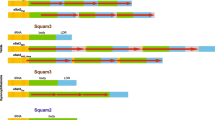Abstract
The highly repeated tandemly arranged satellite DNA from the MSAT-160 family has been studied in 4 species of common vole (the Microtus arvalis group). All the monomer units analysed were classified into 4 subfamilies on the basis of similar nucleotide substitutions. The first 3 subfamilies do not show any species specificity since they combine monomers from several of the vole species examined; the fourth subfamily contains monomer units with substitutions specific to M. arvalis. Certain monomers of different species within the first 3 subfamilies display additional identical substitutions, making them more similar. Despite considerable similarity in monomer sequence within the subfamilies, specific features were found for each of the 4 species. A specific ratio of each type of monomer belonging to the corresponding subfamilies is typical of each species. In addition, the genomes of common vole species differ in the abundance of the MSAT-160 DNA, its pericentromeric location and organization. The mechanisms possibly involved in the evolution of the common vole MSAT-160 sequences are discussed.
Similar content being viewed by others
References
Baltimore D (1981) Gene conversion: some implications for immunoglobulin genes. Cell 211: 592–594.
Besansky NJ, Pewell JR, Caccone A, Hamm DM, Scott JA, Collins FH (1994) Molecular phylogeny of the Anopheles gambiae complex suggest genetic introgression between principal malaria vectors. Proc Natl Sci USA 91: 6885–6888.
Dover GA (1982) Molecular drive: a cohesive mode of species evolution. Nature 289: 111–117.
Dover GA, Brown SD, Coen ES, Dallas J, Strachan T, Trick M (1981) The dynamics of genome evolution and species differentiation. In: Dover GA, Flavell RB, eds. Genome Evolution. London: Academic Press, pp 343–372.
Fatnes JA, Oghene K, Boyle S (1995) A high resolution integrated physical, cytogenetic and genetic map of human chromosome 11 from distal region of 13p to the proximal part of 15.1. Genomics 25: 447–461.
Ivanov SV, Modi WS (1996) Molecular characterization of the complex sex-chromosome heterochromatin in the rodent Microtus chrotorrhinus. Cytogenet Cell Genet 75: 49–56.
Jones R, Potter S (1985) Characterization of cloned human alphoid satellite with unusual monomeric construction: evidence for enrichment in HeLa small polydispersed circular DNA. Nucleic Acids Res 13: 1027–1042.
Kunze B, Weichenhand D, Virks P, Traut W, Winking H (1996) Copy numbers of a clustered long-range repeat determine C-band staining. Cytogenet Cell Genet 73: 86–91.
Mazurok NA, Rubtsova NV, Isaenko AA et al. (2001) Comparative chromosome and mitochondrial DNA analyses and phylogenetic relationships within common voles (Microtus, Arvicolidae). Chromosome Res. 9: 107–120.
Meyer MN, Radjabli SI, Bulatova NSh, Golenishchev FN (1985) Karyological peculiarities and probable relations of common voles of the group arvalis (Rodentia, Cricetidae, Microtus). Zool J 64: 417–428.
Modi WS (1992) Nucleotide sequence and genomic organisation of a tandem satellite array from the rock vole Microtus chrotorrhinus (Rodentia). Mammalian Genome 3: 226–232.
Modi WS (1993a) Comparative analyses of heterochromatin in Microtus: sequence heterogeneity and localised expansion and contraction of satellite DNA arrays. Cytogenet Cell Genet 62: 142–148.
Modi WS (1993b) Heterogeneity of the concerted evolution process in a tandem satellite array from meadow mice (Microtus). J Mol Evol 37: 48–56.
Sambrook J, Fritsch EF, Maniatis T (1989) Molecular Cloning: A Laboratory Manual. New York: Cold Spring Harbor Laboratory Press.
Singer MF (1982) Highly repeated sequences in mammalian genome. Int Rev Cytol 76: 67–112.
Smith GP (1976) Evolution of repeated DNA sequences by unequal crossing over. Science 191: 528–535.
Stark GR, Debatisse M, Grulotto E, Walh GM (1989) Recent progress in understanding mechanisms of mammalian DNA amplification. Cell 57: 901–908.
Walsh JB (1987) Persistence of tandem arrays: implication for satellite and simple-sequence DNA. Genetics 155: 553–567.
Author information
Authors and Affiliations
Rights and permissions
About this article
Cite this article
Shevchenko, A.I., Mazurok, N.A., Slobodyanyuk, S.Y. et al. Comparative analysis of the MSAT-160 repeats in four species of common vole (Microtus, Arvicolidae). Chromosome Res 10, 117–126 (2002). https://doi.org/10.1023/A:1014996917739
Issue Date:
DOI: https://doi.org/10.1023/A:1014996917739




